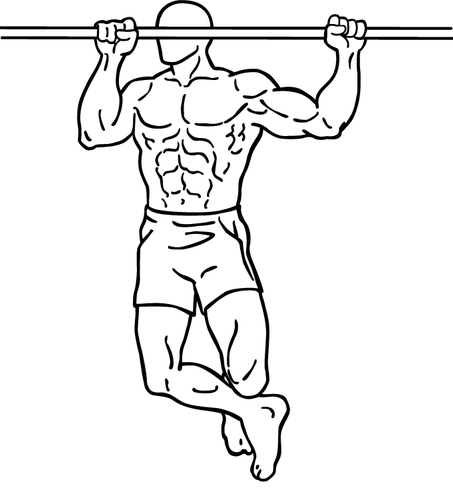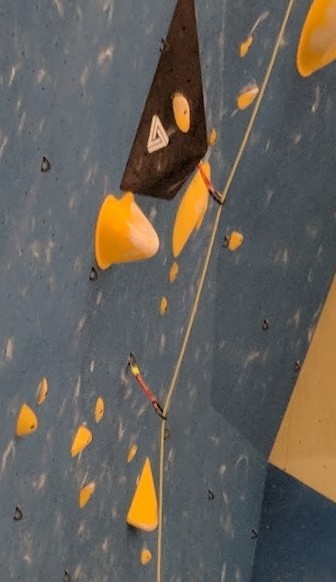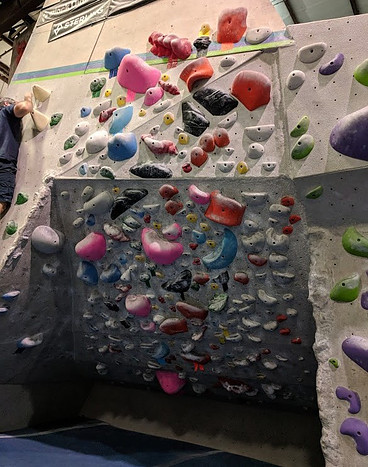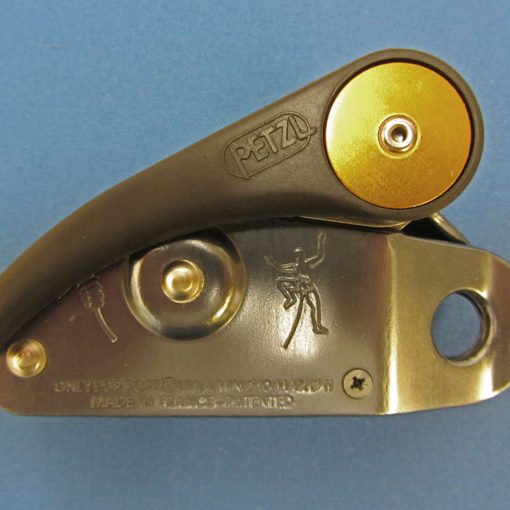There are many exercises to help strengthen your muscles and improve your climbing. However, keep in mind one of the best ways to get better in rock climbing is to climb and climb and climb. How often? For a starter, you may want to consistently and continuously climb at least two to three times weekly.
There are different muscle groups that strengthen when doing a pull-up. The forearms and back are activated during pull-ups. They are very important muscles that help with climbing. In this article, we will focus on the different variations of pull-ups.
What muscle Group?
The pull-ups work on the back muscles that target the latissimus dorsi. This is a large flat muscle on the back. It stretches to the side and behind the arms from the mid to the lower back. It is also commonly called “lats”.![By SalehFoush (Own work) [CC BY-SA 3.0 (https://creativecommons.org/licenses/by-sa/3.0)], via Wikimedia Commons Body_muscles](https://rockclimbingforwomen.com/wp-content/uploads/2018/03/Body_muscles-300x232.jpg)
Other muscles are the brachialis and brachioradialis in the arms. They are located near the elbow and help move the forearm. The brachialis is the biceps and triceps.
The pull up to activate the shoulder muscles such as teres major, rhomboids, trapezius, levator scapulae, and the deltoid muscles. The teres major is a small muscle at the back of the shoulder blade. The rhomboids connect the spine to the shoulder blade. The trapezius locates along the spine and shoulder while the levator scapulae locate along the side of the neck. These muscles are sometimes called the “shrugging muscles” which support to elevate and depress the shoulder blade. The deltoid muscle is a group of muscles forming the shoulder. The pull up primary use the posterior deltoids. The posterior deltoids are from the lower lip of the posterior border of the spine of the scapula.
These muscles are connected and attached to the abdominal muscles along with hip flexors and pelvic floor muscles to lift the lower body and stabilizing the pelvic when doing the pull-up. The muscles of the forearms and the hands are also engaged to hold and lift the overall body weight, creating isometric contraction. An isometric contraction is a form of exercise involving static contraction where the joint and muscle length do not change during contraction. The exercise is static while working against a resistance object.
I believe rock climbing strengthen the stabilizer muscles most. Stabilizer muscles are supporting muscles that balance and a stable certain part of the body so that the primary muscles can do their jobs efficiently. For example, the rear deltoids are frequently acted as a stabilizer for the movement of the shoulders.
You may notice that rock climber’s muscle tone is long, lean, and sinewy instead of big and bulky. Most of the movements by a rock climber require the distribution of weight activating the stabilizer muscles to spread the work of movement throughout the body instead of focusing only on one or two primary muscles.
Variation of exercise
There are varieties of pull-ups to help make our lives interesting:
- Pull up with overgrip – This pull up is where your hand grips are over the bars. From the hanging position where your arms are slightly straight hanging from the bar, you pull yourself upbringing your chin above the bar. As your chin raises over the bar, you count that as one pull up. Then slowly bring your body with control down again to the hanging position. Remember to have your feet dangling or crossed. Do not touch anything on the ground. Keep your body steady and not swinging back and forth. Start with one pull up and then build up as much as you can handle. This pull-up is excellent for strengthening your back.

If you find it is hard to start, you can modify the pull-up with assistance such as have a partner to hold your feet while you do your first pull up or prop your feet against the wall or an object in front of you while doing the pull-up.
- Pull up Frenchie – Once you can do more than five pull-ups, you may want to try to challenge yourself with the Frenchie. This is a grueling pull up with three different holding positions. First, you bring your body up and hold your chin at the top of the bar for at least three seconds then bring yourself down to the initial position.
 Without resting, bring your body up to the top then lower it to the mid position where your elbows are at a 90-degree angle from the bars. Hold for at least three seconds and then lower to the initial hanging position. Again do not take a break yet, raise your chin above the bar, then lower it to the third hold position where your elbow is at 120 degrees from the bars. Hold for at least three more seconds. Finally, bring your body back down to the initial rest hanging position. This is one Frenchie. Build up your muscles to several sets of Frenchies and this will help with your muscle endurance while climbing. It is not an easy exercise at first. Do your best without cheating. Stay in good form and posture. This will help prevent injuries or developing bad habits. Frenchie is an excellent isometric training exercise in building endurance while hanging on a rock or a hold. Sometimes all you need is only a few seconds of strength to help pull yourself up to the next move.
Without resting, bring your body up to the top then lower it to the mid position where your elbows are at a 90-degree angle from the bars. Hold for at least three seconds and then lower to the initial hanging position. Again do not take a break yet, raise your chin above the bar, then lower it to the third hold position where your elbow is at 120 degrees from the bars. Hold for at least three more seconds. Finally, bring your body back down to the initial rest hanging position. This is one Frenchie. Build up your muscles to several sets of Frenchies and this will help with your muscle endurance while climbing. It is not an easy exercise at first. Do your best without cheating. Stay in good form and posture. This will help prevent injuries or developing bad habits. Frenchie is an excellent isometric training exercise in building endurance while hanging on a rock or a hold. Sometimes all you need is only a few seconds of strength to help pull yourself up to the next move.
- Pull up corn cob eater – Another form of pull up is the corn cob eater. It is pretty straight forward as the name.
![By Everkinetic (http://everkinetic.com/) [CC BY-SA 3.0 (https://creativecommons.org/licenses/by-sa/3.0)], via Wikimedia Commons chin up](data:image/gif;base64,R0lGODlhAQABAIAAAAAAAP///yH5BAEAAAAALAAAAAABAAEAAAIBRAA7) This pull-up is where you bring your chin above the bar, with your neck shift your weight from left to right like eating corn on the cob. Then bring your body back down to the hanging position. Repeat for the right to the left. Start with one or two sets and then build up to as many as you can manage.
This pull-up is where you bring your chin above the bar, with your neck shift your weight from left to right like eating corn on the cob. Then bring your body back down to the hanging position. Repeat for the right to the left. Start with one or two sets and then build up to as many as you can manage.
- Pull up, muscle up – From the initial hanging position, pull up hard and pass the bar. Push and press-up your body into a front support position on the bar. This is where both arms are straight and extended above the bar. Your waist is slightly higher than the bar level. This move is helpful when you are in a location that requires muscle up a high positioned rock. You can pull your body up higher so that you can prop your feet in position for leverage.
- Pull up in a tuck position – This is a simple pull up where your legs are in a tuck position. A tuck position is where you bend your knees up to your tummy like you are doing a cannonball jump. From the initial hanging position, pull your chin up slightly past the bar keeping your legs in a tuck position. Then slowly bring your body down to the initial hanging position. Start with one then build up to as many as you can manage in your routine.
- Pull up in a pike position – This is another form of pull up with your legs straight out as much as possible in a pike position. A pike position is where you want your legs to be straight and horizontal making a shape of an “L” with your body. This is not an easy position to achieve at first. It takes a lot of core strength to keep the “L” shape let alone doing a pull-up with the “L” shape. Once you establish your pike position with your body, pull up your chin pass the bar, and then bring your body down slowly while keeping the pike shape. Start with one and then build up to as many as you can manage.
- One arm pull up – This is an advance pull up. Use one arm holding to vertical bar and the other arm doing the pull-up. This pull-up is definitely a challenge for those who want more variety. Occasionally and rarely, there are positions while climbing that would require one arm pull up.
- Hang: This is not necessary a pull-up. It is a hanging exercise that also builds endurance on your grip and strengthens your forearm muscle. Start hanging with two arms on a bar for ten seconds and build up the time. You’ll be surprised how hard it is to hang for just 30 seconds. You can also hang using hang boards at the climbing gym to build up grip strengths for different types of holds. There are varieties of holds large rung, middle rung, small rung, pockets, slopes, edges, etc.
The benefit of pull-ups
Pull up exercises help strengthen your grip for your forearms as well as working your lats, shoulder, and other muscle groups mentioned in this article. Just hanging suspended off the ground with your arms slightly bent can help improve your posture and strengthen your back and core muscles.
Pull-ups also relieve back pain. My husband was born with a curved spine. Growing up, he constantly had back pain. Over the years, he found doing pull-ups help alleviate his back pain and improve his quality of life physically.
Using your own body weight is an excellent way to tone your muscle. I found it simple and very effective. You can do it anywhere as long as there is a bar or something to hang from. Pull up is an excellent exercise that tone the upper body and produces a nice slim waist. Yes, it does help improve your climbing strength and endurance.
How to integrate the pull-ups to rock climbing?
Pull up in a muscle-up is an excellent example of an exercise that you can incorporate when climbing. There are certainly hard top rope routes such as grade 5.10 and up that require a muscle-up. It is usually a higher hold where you have both arms holding onto that hold and pull your whole body up. As you achieve a certain height where your upper body passes your hands, start the transition from a pull to a press straight up with your arms. Lean over to the left or the right slightly and allow your feet to step up and position to the next hold. This is not an easy move and requires a lot of strength. The pull up – muscle up exercises really helps.
I also found myself do a lot of pull-ups while climbing without even realizing it. Most of the pull-ups are quick within less than three seconds. Sometimes I use my feet, smearing against the wall to help with the pull-up. This requires less energy than pulling up without aid. Over time, the more I climb the more I become familiar with the positioning, the shifting, and the transitioning from one move to the next. I become more efficient and effective which helps me with building muscle endurance.
Conclusion
A common question – “Should I learn how to do a pull up first before I climb?” or a belief “I can’t climb until my upper body is strong enough” sometimes prevent people from trying out rock climbing. It is usually a fear of the unknown.
I am here to share with you that you do not have to be able to do a pull up before you can climb.
I met a friend who has been climbing for over ten years. She is an excellent climber with wonderful techniques. However, she cannot do one single pull up without aid. My friend is a great example of someone who cannot do a single pull up and still is an excellent rock climber.
I myself can barely do several pull-ups without cheating before I learned to climb. I started climbing and over time I build up strength and endurance. I can now do up to ten pull-ups. I have not been training any pull-ups or weights. All I did was climbed two to three times a week for the past five years. Now, I am at a stagnant point in my climbing. I would like to take my challenge to the next level. In order to so, I would need to train. Doing pull-ups and hanging exercises are a great starting point for me. I look forward to challenging myself to the next level.
I hope this article is helpful and perhaps debunk a myth about how strong do you need to be before you can climb. If you have any questions or comments, please leave them below. I love to hear your thoughts on how you have improved your climbing.




![By Everkinetic (http://everkinetic.com/) [CC BY-SA 3.0 (https://creativecommons.org/licenses/by-sa/3.0)], via Wikimedia Commons chin up](https://rockclimbingforwomen.com/wp-content/uploads/2017/10/chin-up-overhand-e1506906942352-276x300.png)




10 thoughts on “Best Pull Up Exercises – Do You Need to Know How to Do a Pull Up in Order to Climb?”
Hi Ha, this is a very informative post, I really didn’t know that many muscles are used when we do pull ups. I will do more pull ups from now, as I understand the full benefits now. However, I’ve never done rock climbing, I may even try this.
Thank you for sharing this.
Habib
You’re welcome, Habib! Thank you for sharing your thoughts. Pull ups are great for you regardless. Rock climbing is also a fun experience and a great exercise. It’s not a requirement both ways. I hope you’ll enjoy climbing when you try it. I love it.
Pull-ups are the best workout for my shoulders and back. I can comfortably do the 15 reps of the pull-up Frenchie.
Excellent!!! That’s hard core. Your shoulders and back must be pretty well define. Thank you for sharing your thoughts.
Excellent article.. Pulls ups are various type and each have different effect on our body, but most of us don’t know about it including myself.. I just know that to prepare for rock climbing you have to start building your body with exercises like that of pull ups…
Thank you for sharing your thoughts, Huzefa. Pull ups is an excellent exercise all around regardless if you rock climb or not. I hope the article was helpful for you.
I used to LOOVE climbing on rock climbing walls as a kid. I would love to get back into this some day as an adult. Very useful information!
Thank you for sharing your thoughts! Rock climbing is definitely a great sport at any age. It’s become very popular these days as well.
Boy did I learn a lot from this article. I knew nothing about rock climbing or pull up training. In fact, I have never actually did a pull up myself. I love the image with the names of the muscles. I’ve been wondering where some of them are located. People talk about Tricepts and bicepts and lats and glutes and I had no idea where they were located. Nice post – Shirley
Thank you Shirley for sharing your thoughts. I am glad you are learning something new about the different muscles and their locations. It’s definitely good to know and understand how we can strengthen our muscles wisely as we age.